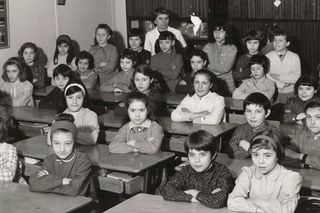
The Difference Between Boys and Girls in the Classroom
How gender influences schooling, and schooling influences gender.

Gender equality in education has long focused on closing the gap in access — efforts that have, in recent years, finally started to pay off. Currently, there are nine girls attending secondary school for every 10 boys, and 68.4% of women are literate, an increase of 13 percentage points over the past decade. These efforts should continue, but with more girls in the classroom, and women graduating, it may be time to also consider the more nuanced ways gender plays out in the classroom.
“Girls tend to sit more quietly, with a few exceptions. But usually they are well behaved. Often I have found that girls also want to move and run about, but they seem to be holding back,” says Judy Shah, who has taught 5- and 6-year-olds for the past six years at two different private schools in Mumbai. “Boys are more energetic and aggressive. They tend to move around a lot. They can often be restless.”
Next School teacher Nikhil Bangera’s observations of kids twice that age are similar. Boys, he says, are more likely to get into confrontations, both verbal and physical.
“The boys who engage in hitting do it almost on a daily basis while the girls would end up getting physical maybe once or twice a year,” Bangera says. By contrast, the girls in his Grade 5 classroom tend to respond verbally to confrontations. They also cooperate more with teachers and show greater maturity.
“There is a girl in my class who is at the receiving end of a boy’s needling. She usually responds rather than reacting to his goading. Last week, a teacher asked my class to make a sentence using the word ‘thoroughly.’ She came up with, ‘We have thoroughly examined [boy]’s head and found that it is empty,'” Bangera says.
It’s difficult to parse nature from nurture from stereotype in this realm. The effect of biological sex on personality and thus, on how we learn, is hazy, and runs into danger of being mistaken for ability. In 2016, one highly cited study found that differences in brain structure could predict whether a brain belonged to a woman or man in about 69 to 77% of cases. Though the similarities that confounded gender identification among the other 23 to 31% are notable, plenty of other research gives conflicting weight to the idea that biological sex shapes personality. There do seem to be differences between the minds of men and women — studies of little girls exposed to high levels of testosterone prenatally due to a congenital disorder show these children tend to be less gender-conforming, and more likely to choose toys that are stereotypically male — but no one truly knows how much and to what degree.
Shah and Bangera both note exceptions to their gendered observations. Shah also says that for some children, the stereotypical behavior they exhibit seems to be innate.
“I have found that sometimes this behaviour can be attributed to natural reasons,” she says. “But on many occasions it seemed that it was a matter of upbringing and cultural influences. Girls were expected to be docile, while boys were encouraged to be rough and tough.”
Bangera says this is especially true for boys.
“With the boys who engage in this behaviour it is usually a case of unobstructed biases and gender roles perpetuating from the adult world,” he says. “They see the people around them engage in such behaviour which they bring to the classroom.”
Shelly Cardozo, a long time teacher of 5- to 7-year-olds in Mumbai, also says media plays a role. Indeed, for many children, even schoolbooks reinforce traditional gender norms.
The roots may go deeper, perhaps; research that examines how parents interact with babies and very young children lends credence to a socialized difference between girls and boys that starts before children are old enough to internalize the gender roles playing out in their homes or in the media. Parents tend to talk to girls more as babies, and are more likely to talk to girls about body parts and emotions, which may contribute to higher EQ and the greater maturity, Bangera and Shah note. By contrast, male babies and young boys are more likely to be engaged in roughhouse play, which contributes to spatial skill building.
It’s a difference that has academic fallout for both genders. Tendencies to talk more to girl babies has been identified as a factor behind a serious and global reading skills deficit among boys, one that far outpaces the reverse gender gap in STEM subjects. But the fallout for girls seems more comprehensive — new research suggests girls are most likely to struggle with social, academic and behavioral issues in adolescence. By college age, boys are more likely than girls to be confident in their intellect. This, despite the fact that a study of 30 countries found girls have consistently outperformed boys across all school subjects for nearly a century.
Shah and Bangera both say they make a point of challenging stereotypes and breaking gender norms when given the opportunity. But not all teachers do so or all able.
“While I have noticed that some teachers make an effort to ensure equality in treatment between boys and girls, there are still some who are of more conservative thinking. And prefer to treat boys and girls differently,” Shah says.
She points out that others may “want to make an effort, [but] often, because of hectic study schedules, gender roles get neglected.”
Which creates a situation wherein gender norms might be reinforced in subtle ways by the very people who may be challenging the same overtly. Decades of research by Myra and David Sadker and Karen R. Zittleman in US classrooms show teacher-student interactions tend to unconsciously reward boys in ways that challenge them to do more, and girls in ways that encourage them to be quiet.
National and state efforts to reduce gender bias in Indian education have taken off in recent years, but understandably remain focused on explaining the concept and rooting out overt stereotyping. Still, some teachers take it further.
“I would let my kids play with whatever toys they wanted,” Shah says. “I found a few boys who were interested in playing with a kitchen set. And I always encouraged that. I would rotate the toys with the children, and try and encourage boys to play with girls toys and vice-versa.”
And Bangera says he is always looking for opportunities to challenge stereotypes.
“If a student makes a statement like ‘crying like a girl’ it leads to a discussion on what prompted the statement and if it holds true. Such instances are continuously challenged and rejected,” he says. “At my current school, in the absence of a fixed syllabi, we can still afford to do so.”
Yet Bangera says he can see how it might be a struggle for some teachers; a lot of online teaching resources still rely on traditional gender roles, he says, which can make keeping stereotypes out of classroom materials a constant battle.
It also makes eliminating more subtly gendered interactions in schools farther off. Indeed, the idea is still rather cutting edge; the most progress any school system in the world has made against this is in Sweden, which is currently taking stock of its 20-some year national experiment in gender-neutral education.
It’s an example Bangera says teachers in India should be watching.
“As long as this is discursive and not directive, its worth continuing,” Bangera says. “We can see the long-term results and learn from them.”
Liesl Goecker is The Swaddle's managing editor.
Related


The Buzz Cut: The Duchess of Cambridge Sets An Impossibly High Bar
